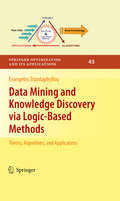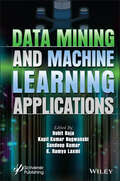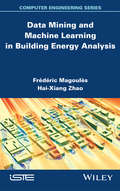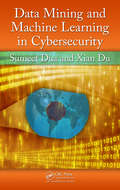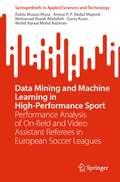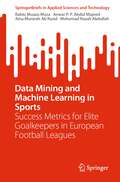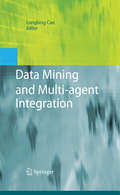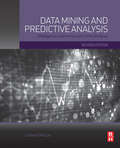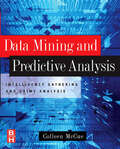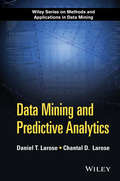- Table View
- List View
Data Mining and Exploration: From Traditional Statistics to Modern Data Science
by Chong Ho Alex YuThis book introduces both conceptual and procedural aspects of cutting-edge data science methods, such as dynamic data visualization, artificial neural networks, ensemble methods, and text mining. There are at least two unique elements that can set the book apart from its rivals. First, most students in social sciences, engineering, and business took at least one class in introductory statistics before learning data science. However, usually these courses do not discuss the similarities and differences between traditional statistics and modern data science; as a result learners are disoriented by this seemingly drastic paradigm shift. In reaction, some traditionalists reject data science altogether while some beginning data analysts employ data mining tools as a “black box”, without a comprehensive view of the foundational differences between traditional and modern methods (e.g., dichotomous thinking vs. pattern recognition, confirmation vs. exploration, single method vs. triangulation, single sample vs. cross-validation etc.). This book delineates the transition between classical methods and data science (e.g. from p value to Log Worth, from resampling to ensemble methods, from content analysis to text mining etc.). Second, this book aims to widen the learner's horizon by covering a plethora of software tools. When a technician has a hammer, every problem seems to be a nail. By the same token, many textbooks focus on a single software package only, and consequently the learner tends to fit the problem with the tool, but not the other way around. To rectify the situation, a competent analyst should be equipped with a tool set, rather than a single tool. For example, when the analyst works with crucial data in a highly regulated industry, such as pharmaceutical and banking, commercial software modules (e.g., SAS) are indispensable. For a mid-size and small company, open-source packages such as Python would come in handy. If the research goal is to create an executive summary quickly, the logical choice is rapid model comparison. If the analyst would like to explore the data by asking what-if questions, then dynamic graphing in JMP Pro is a better option. This book uses concrete examples to explain the pros and cons of various software applications.
Data Mining and Exploration: From Traditional Statistics to Modern Data Science
by Chong Ho Alex YuThis book introduces both conceptual and procedural aspects of cutting-edge data science methods, such as dynamic data visualization, artificial neural networks, ensemble methods, and text mining. There are at least two unique elements that can set the book apart from its rivals. First, most students in social sciences, engineering, and business took at least one class in introductory statistics before learning data science. However, usually these courses do not discuss the similarities and differences between traditional statistics and modern data science; as a result learners are disoriented by this seemingly drastic paradigm shift. In reaction, some traditionalists reject data science altogether while some beginning data analysts employ data mining tools as a “black box”, without a comprehensive view of the foundational differences between traditional and modern methods (e.g., dichotomous thinking vs. pattern recognition, confirmation vs. exploration, single method vs. triangulation, single sample vs. cross-validation etc.). This book delineates the transition between classical methods and data science (e.g. from p value to Log Worth, from resampling to ensemble methods, from content analysis to text mining etc.). Second, this book aims to widen the learner's horizon by covering a plethora of software tools. When a technician has a hammer, every problem seems to be a nail. By the same token, many textbooks focus on a single software package only, and consequently the learner tends to fit the problem with the tool, but not the other way around. To rectify the situation, a competent analyst should be equipped with a tool set, rather than a single tool. For example, when the analyst works with crucial data in a highly regulated industry, such as pharmaceutical and banking, commercial software modules (e.g., SAS) are indispensable. For a mid-size and small company, open-source packages such as Python would come in handy. If the research goal is to create an executive summary quickly, the logical choice is rapid model comparison. If the analyst would like to explore the data by asking what-if questions, then dynamic graphing in JMP Pro is a better option. This book uses concrete examples to explain the pros and cons of various software applications.
Data Mining and Knowledge Discovery Approaches Based on Rule Induction Techniques (Massive Computing #6)
by Evangelos Triantaphyllou Giovanni FeliciThis book outlines the core theory and practice of data mining and knowledge discovery (DM & KD) examining theoretical foundations for various methods, and presenting an array of examples, many drawn from real-life applications. Most theoretical developments are accompanied by extensive empirical analysis, offering a deep insight into both theoretical and practical aspects of the subject. The book presents the combined research experiences of 40 expert contributors of world renown.
Data Mining and Knowledge Discovery for Big Data: Methodologies, Challenge and Opportunities (Studies in Big Data #1)
by Wesley W. ChuThe field of data mining has made significant and far-reaching advances over the past three decades. Because of its potential power for solving complex problems, data mining has been successfully applied to diverse areas such as business, engineering, social media, and biological science. Many of these applications search for patterns in complex structural information. In biomedicine for example, modeling complex biological systems requires linking knowledge across many levels of science, from genes to disease. Further, the data characteristics of the problems have also grown from static to dynamic and spatiotemporal, complete to incomplete, and centralized to distributed, and grow in their scope and size (this is known as big data). The effective integration of big data for decision-making also requires privacy preservation. The contributions to this monograph summarize the advances of data mining in the respective fields. This volume consists of nine chapters that address subjects ranging from mining data from opinion, spatiotemporal databases, discriminative subgraph patterns, path knowledge discovery, social media, and privacy issues to the subject of computation reduction via binary matrix factorization.
Data Mining and Knowledge Discovery for Process Monitoring and Control (Advances in Industrial Control)
by Xue Z. WangModern computer-based control systems are able to collect a large amount of information, display it to operators and store it in databases but the interpretation of the data and the subsequent decision making relies mainly on operators with little computer support. This book introduces developments in automatic analysis and interpretation of process-operational data both in real-time and over the operational history, and describes new concepts and methodologies for developing intelligent, state space-based systems for process monitoring, control and diagnosis. The book brings together new methods and algorithms from process monitoring and control, data mining and knowledge discovery, artificial intelligence, pattern recognition, and causal relationship discovery, as well as signal processing. It also provides a framework for integrating plant operators and supervisors into the design of process monitoring and control systems.
Data Mining and Knowledge Discovery Handbook
by Oded Maimon Lior RokachData Mining and Knowledge Discovery Handbook organizes all major concepts, theories, methodologies, trends, challenges and applications of data mining (DM) and knowledge discovery in databases (KDD) into a coherent and unified repository. This book first surveys, then provides comprehensive yet concise algorithmic descriptions of methods, including classic methods plus the extensions and novel methods developed recently. This volume concludes with in-depth descriptions of data mining applications in various interdisciplinary industries including finance, marketing, medicine, biology, engineering, telecommunications, software, and security. Data Mining and Knowledge Discovery Handbook is designed for research scientists and graduate-level students in computer science and engineering. This book is also suitable for professionals in fields such as computing applications, information systems management, and strategic research management.
Data Mining and Knowledge Discovery Handbook
by Oded Maimon Lior RokachThis book organizes key concepts, theories, standards, methodologies, trends, challenges and applications of data mining and knowledge discovery in databases. It first surveys, then provides comprehensive yet concise algorithmic descriptions of methods, including classic methods plus the extensions and novel methods developed recently. It also gives in-depth descriptions of data mining applications in various interdisciplinary industries.
Data Mining and Knowledge Discovery via Logic-Based Methods: Theory, Algorithms, and Applications (Springer Optimization and Its Applications #43)
by Evangelos TriantaphyllouThe importance of having ef cient and effective methods for data mining and kn- ledge discovery (DM&KD), to which the present book is devoted, grows every day and numerous such methods have been developed in recent decades. There exists a great variety of different settings for the main problem studied by data mining and knowledge discovery, and it seems that a very popular one is formulated in terms of binary attributes. In this setting, states of nature of the application area under consideration are described by Boolean vectors de ned on some attributes. That is, by data points de ned in the Boolean space of the attributes. It is postulated that there exists a partition of this space into two classes, which should be inferred as patterns on the attributes when only several data points are known, the so-called positive and negative training examples. The main problem in DM&KD is de ned as nding rules for recognizing (cl- sifying) new data points of unknown class, i. e. , deciding which of them are positive and which are negative. In other words, to infer the binary value of one more attribute, called the goal or class attribute. To solve this problem, some methods have been suggested which construct a Boolean function separating the two given sets of positive and negative training data points.
Data Mining and Knowledge Discovery with Evolutionary Algorithms (Natural Computing Series)
by Alex A. FreitasThis book integrates two areas of computer science, namely data mining and evolutionary algorithms. Both these areas have become increasingly popular in the last few years, and their integration is currently an active research area. In general, data mining consists of extracting knowledge from data. The motivation for applying evolutionary algorithms to data mining is that evolutionary algorithms are robust search methods which perform a global search in the space of candidate solutions. This book emphasizes the importance of discovering comprehensible, interesting knowledge, which is potentially useful for intelligent decision making. The text explains both basic concepts and advanced topics
Data Mining and Knowledge Management: Chinese Academy of Sciences Symposium CASDMKD 2004, Beijing, China, July 12-14, 2004, Revised Paper (Lecture Notes in Computer Science #3327)
by Yong Shi Weixuan Xu Zhengxin Chencriteria linear and nonlinear programming has proven to be a very useful approach. • Knowledge management for enterprise: These papers address various issues related to the application of knowledge management in corporations using various techniques. A particular emphasis here is on coordination and cooperation. • Risk management: Better knowledge management also requires more advanced techniques for risk management, to identify, control, and minimize the impact of uncertain events, as shown in these papers, using fuzzy set theory and other approaches for better risk management. • Integration of data mining and knowledge management: As indicated earlier, the integration of these two research fields is still in the early stage. Nevertheless, as shown in the papers selected in this volume, researchers have endearored to integrate data mining methods such as neural networks with various aspects related to knowledge management, such as decision support systems and expert systems, for better knowledge management. September 2004 Yong Shi Weixuan Xu Zhengxin Chen CASDMKM 2004 Organization Hosted by Institute of Policy and Management at the Chinese Academy of Sciences Graduate School of the Chinese Academy of Sciences International Journal of Information Technology and Decision Making Sponsored by Chinese Academy of Sciences National Natural Science Foundation of China University of Nebraska at Omaha, USA Conference Chairs Weixuan Xu, Chinese Academy of Sciences, China Yong Shi, University of Nebraska at Omaha, USA Advisory Committee
Data Mining and Learning Analytics: Applications in Educational Research (Wiley Series on Methods and Applications in Data Mining)
by Samira Elatia Donald Ipperciel Osmar R. ZaïaneAddresses the impacts of data mining on education and reviews applications in educational research teaching, and learning This book discusses the insights, challenges, issues, expectations, and practical implementation of data mining (DM) within educational mandates. Initial series of chapters offer a general overview of DM, Learning Analytics (LA), and data collection models in the context of educational research, while also defining and discussing data mining’s four guiding principles— prediction, clustering, rule association, and outlier detection. The next series of chapters showcase the pedagogical applications of Educational Data Mining (EDM) and feature case studies drawn from Business, Humanities, Health Sciences, Linguistics, and Physical Sciences education that serve to highlight the successes and some of the limitations of data mining research applications in educational settings. The remaining chapters focus exclusively on EDM’s emerging role in helping to advance educational research—from identifying at-risk students and closing socioeconomic gaps in achievement to aiding in teacher evaluation and facilitating peer conferencing. This book features contributions from international experts in a variety of fields. Includes case studies where data mining techniques have been effectively applied to advance teaching and learning Addresses applications of data mining in educational research, including: social networking and education; policy and legislation in the classroom; and identification of at-risk students Explores Massive Open Online Courses (MOOCs) to study the effectiveness of online networks in promoting learning and understanding the communication patterns among users and students Features supplementary resources including a primer on foundational aspects of educational mining and learning analytics Data Mining and Learning Analytics: Applications in Educational Research is written for both scientists in EDM and educators interested in using and integrating DM and LA to improve education and advance educational research.
Data Mining and Learning Analytics: Applications in Educational Research (Wiley Series on Methods and Applications in Data Mining)
by Samira ElAtia Osmar R. Zaiane Donald IppercielAddresses the impacts of data mining on education and reviews applications in educational research teaching, and learning This book discusses the insights, challenges, issues, expectations, and practical implementation of data mining (DM) within educational mandates. Initial series of chapters offer a general overview of DM, Learning Analytics (LA), and data collection models in the context of educational research, while also defining and discussing data mining’s four guiding principles— prediction, clustering, rule association, and outlier detection. The next series of chapters showcase the pedagogical applications of Educational Data Mining (EDM) and feature case studies drawn from Business, Humanities, Health Sciences, Linguistics, and Physical Sciences education that serve to highlight the successes and some of the limitations of data mining research applications in educational settings. The remaining chapters focus exclusively on EDM’s emerging role in helping to advance educational research—from identifying at-risk students and closing socioeconomic gaps in achievement to aiding in teacher evaluation and facilitating peer conferencing. This book features contributions from international experts in a variety of fields. Includes case studies where data mining techniques have been effectively applied to advance teaching and learning Addresses applications of data mining in educational research, including: social networking and education; policy and legislation in the classroom; and identification of at-risk students Explores Massive Open Online Courses (MOOCs) to study the effectiveness of online networks in promoting learning and understanding the communication patterns among users and students Features supplementary resources including a primer on foundational aspects of educational mining and learning analytics Data Mining and Learning Analytics: Applications in Educational Research is written for both scientists in EDM and educators interested in using and integrating DM and LA to improve education and advance educational research.
Data Mining and Machine Learning Applications
by Kapil Kumar Nagwanshi Rohit Raja Sandeep Kumar K. Ramya LaxmiDATA MINING AND MACHINE LEARNING APPLICATIONS The book elaborates in detail on the current needs of data mining and machine learning and promotes mutual understanding among research in different disciplines, thus facilitating research development and collaboration. Data, the latest currency of today’s world, is the new gold. In this new form of gold, the most beautiful jewels are data analytics and machine learning. Data mining and machine learning are considered interdisciplinary fields. Data mining is a subset of data analytics and machine learning involves the use of algorithms that automatically improve through experience based on data. Massive datasets can be classified and clustered to obtain accurate results. The most common technologies used include classification and clustering methods. Accuracy and error rates are calculated for regression and classification and clustering to find actual results through algorithms like support vector machines and neural networks with forward and backward propagation. Applications include fraud detection, image processing, medical diagnosis, weather prediction, e-commerce and so forth. The book features: A review of the state-of-the-art in data mining and machine learning, A review and description of the learning methods in human-computer interaction, Implementation strategies and future research directions used to meet the design and application requirements of several modern and real-time applications for a long time, The scope and implementation of a majority of data mining and machine learning strategies. A discussion of real-time problems. Audience Industry and academic researchers, scientists, and engineers in information technology, data science and machine and deep learning, as well as artificial intelligence more broadly.
Data Mining and Machine Learning Applications
by Rohit Raja Kapil Kumar Nagwanshi Sandeep Kumar K. Ramya LaxmiDATA MINING AND MACHINE LEARNING APPLICATIONS The book elaborates in detail on the current needs of data mining and machine learning and promotes mutual understanding among research in different disciplines, thus facilitating research development and collaboration. Data, the latest currency of today’s world, is the new gold. In this new form of gold, the most beautiful jewels are data analytics and machine learning. Data mining and machine learning are considered interdisciplinary fields. Data mining is a subset of data analytics and machine learning involves the use of algorithms that automatically improve through experience based on data. Massive datasets can be classified and clustered to obtain accurate results. The most common technologies used include classification and clustering methods. Accuracy and error rates are calculated for regression and classification and clustering to find actual results through algorithms like support vector machines and neural networks with forward and backward propagation. Applications include fraud detection, image processing, medical diagnosis, weather prediction, e-commerce and so forth. The book features: A review of the state-of-the-art in data mining and machine learning, A review and description of the learning methods in human-computer interaction, Implementation strategies and future research directions used to meet the design and application requirements of several modern and real-time applications for a long time, The scope and implementation of a majority of data mining and machine learning strategies. A discussion of real-time problems. Audience Industry and academic researchers, scientists, and engineers in information technology, data science and machine and deep learning, as well as artificial intelligence more broadly.
Data Mining and Machine Learning in Building Energy Analysis: Towards High Performance Computing (Iste Ser.)
by Frédéric Magoules Hai-Xiang ZhaoFocusing on up-to-date artificial intelligence models to solve building energy problems, Artificial Intelligence for Building Energy Analysis reviews recently developed models for solving these issues, including detailed and simplified engineering methods, statistical methods, and artificial intelligence methods. The text also simulates energy consumption profiles for single and multiple buildings. Based on these datasets, Support Vector Machine (SVM) models are trained and tested to do the prediction. Suitable for novice, intermediate, and advanced readers, this is a vital resource for building designers, engineers, and students.
Data Mining and Machine Learning in Building Energy Analysis: Towards High Performance Computing
by Frédéric Magoules Hai-Xiang ZhaoFocusing on up-to-date artificial intelligence models to solve building energy problems, Artificial Intelligence for Building Energy Analysis reviews recently developed models for solving these issues, including detailed and simplified engineering methods, statistical methods, and artificial intelligence methods. The text also simulates energy consumption profiles for single and multiple buildings. Based on these datasets, Support Vector Machine (SVM) models are trained and tested to do the prediction. Suitable for novice, intermediate, and advanced readers, this is a vital resource for building designers, engineers, and students.
Data Mining and Machine Learning in Cybersecurity
by Sumeet Dua Xian DuWith the rapid advancement of information discovery techniques, machine learning and data mining continue to play a significant role in cybersecurity. Although several conferences, workshops, and journals focus on the fragmented research topics in this area, there has been no single interdisciplinary resource on past and current works and possible
Data Mining and Machine Learning in Cybersecurity
by Sumeet Dua Xian DuWith the rapid advancement of information discovery techniques, machine learning and data mining continue to play a significant role in cybersecurity. Although several conferences, workshops, and journals focus on the fragmented research topics in this area, there has been no single interdisciplinary resource on past and current works and possible
Data Mining and Machine Learning in High-Performance Sport: Performance Analysis of On-field and Video Assistant Referees in European Soccer Leagues (SpringerBriefs in Applied Sciences and Technology)
by Rabiu Muazu Musa Anwar P.P. Abdul Majeed Mohd Azraai Mohd Razman Mohamad Razali Abdullah Garry KuanThis book explores the application of data mining and machine learning techniques in studying the activity pattern, decision-making skills, misconducts, and actions resulting in the intervention of VAR in European soccer leagues referees. The game of soccer at the elite level is characterised by intense competitions, a high level of intensity, technical, and tactical skills coupled with a long duration of play. Referees are required to officiate the game and deliver correct and indisputable decisions throughout the duration of play. The increase in the spatial and temporal task demands of the game necessitates that the referees must respond and cope with the physiological and psychological loads inherent in the game. The referees are also required to deliver an accurate decision and uphold the rules and regulations of the game during a match. These demands and attributes make the work of referees highly complex. The increasing pace and complexity of the game resulted in the introduction of the Video Assistant Referee (VAR) to assist and improve the decision-making of on-field referees. Despite the integration of VAR into the current refereeing system, the performances of the referees are yet to be error-free. Machine learning coupled with data mining techniques has shown to be vital in providing insights from a large dataset which could be used to draw important inferences that can aid decision-making for diagnostics purposes and overall performance improvement. A total of 6232 matches from 5 consecutive seasons officiated across the English Premier League, Spanish LaLiga, Italian Serie A as well as the German Bundesliga was studied. It is envisioned that the findings in this book could be useful in recognising the activity pattern of top-class referees, that is non-trivial for the stakeholders in devising strategies to further enhance the performances of referees as well as empower talent identification experts with pertinent information for mapping out future high-performance referees.
Data Mining and Machine Learning in Sports: Success Metrics for Elite Goalkeepers in European Football Leagues (SpringerBriefs in Applied Sciences and Technology)
by Rabiu Muazu Musa Anwar P. Majeed Aina Munirah Ab Rasid Mohamad Razali AbdullahThis brief highlights the factors associated with good goalkeeping techniques and their impact on goalkeepers’ performance in elite European football leagues. The goalkeeping performances of 1600 goalkeepers from five consecutive seasons across the English Premier League, Spanish La Liga, Italian Serie A, and German Bundesliga are studied. The findings from this brief are useful for identifying the success metrices of top-class goalkeepers that help stakeholders to devise strategies to further enhance their performances and empower talent identification experts with pertinent information for mapping out future high-performance goalkeepers.
Data Mining and Multi-agent Integration
by Longbing CaoData Mining and Multi agent Integration aims to re?ect state of the art research and development of agent mining interaction and integration (for short, agent min ing). The book was motivated by increasing interest and work in the agents data min ing, and vice versa. The interaction and integration comes about from the intrinsic challenges faced by agent technology and data mining respectively; for instance, multi agent systems face the problem of enhancing agent learning capability, and avoiding the uncertainty of self organization and intelligence emergence. Data min ing, if integrated into agent systems, can greatly enhance the learning skills of agents, and assist agents with predication of future states, thus initiating follow up action or intervention. The data mining community is now struggling with mining distributed, interactive and heterogeneous data sources. Agents can be used to man age such data sources for data access, monitoring, integration, and pattern merging from the infrastructure, gateway, message passing and pattern delivery perspectives. These two examples illustrate the potential of agent mining in handling challenges in respective communities. There is an excellent opportunity to create innovative, dual agent mining interac tion and integration technology, tools and systems which will deliver results in one new technology.
Data Mining and Predictive Analysis: Intelligence Gathering and Crime Analysis
by Colleen McCueData Mining and Predictive Analysis: Intelligence Gathering and Crime Analysis, 2nd Edition, describes clearly and simply how crime clusters and other intelligence can be used to deploy security resources most effectively. Rather than being reactive, security agencies can anticipate and prevent crime through the appropriate application of data mining and the use of standard computer programs. Data Mining and Predictive Analysis offers a clear, practical starting point for professionals who need to use data mining in homeland security, security analysis, and operational law enforcement settings. This revised text highlights new and emerging technology, discusses the importance of analytic context for ensuring successful implementation of advanced analytics in the operational setting, and covers new analytic service delivery models that increase ease of use and access to high-end technology and analytic capabilities. The use of predictive analytics in intelligence and security analysis enables the development of meaningful, information based tactics, strategy, and policy decisions in the operational public safety and security environment.Discusses new and emerging technologies and techniques, including up-to-date information on predictive policing, a key capability in law enforcement and securityDemonstrates the importance of analytic context beyond softwareCovers new models for effective delivery of advanced analytics to the operational environment, which have increased access to even the most powerful capabilitiesIncludes terminology, concepts, practical application of these concepts, and examples to highlight specific techniques and approaches in crime and intelligence analysis
Data Mining and Predictive Analysis: Intelligence Gathering and Crime Analysis
by Colleen McCueIt is now possible to predict the future when it comes to crime. In Data Mining and Predictive Analysis, Dr. Colleen McCue describes not only the possibilities for data mining to assist law enforcement professionals, but also provides real-world examples showing how data mining has identified crime trends, anticipated community hot-spots, and refined resource deployment decisions. In this book Dr. McCue describes her use of "off the shelf" software to graphically depict crime trends and to predict where future crimes are likely to occur. Armed with this data, law enforcement executives can develop "risk-based deployment strategies," that allow them to make informed and cost-efficient staffing decisions based on the likelihood of specific criminal activity.Knowledge of advanced statistics is not a prerequisite for using Data Mining and Predictive Analysis. The book is a starting point for those thinking about using data mining in a law enforcement setting. It provides terminology, concepts, practical application of these concepts, and examples to highlight specific techniques and approaches in crime and intelligence analysis, which law enforcement and intelligence professionals can tailor to their own unique situation and responsibilities.* Serves as a valuable reference tool for both the student and the law enforcement professional* Contains practical information used in real-life law enforcement situations* Approach is very user-friendly, conveying sophisticated analyses in practical terms
Data Mining and Predictive Analytics (Wiley Series on Methods and Applications in Data Mining)
by Daniel T. LaroseLearn methods of data analysis and their application to real-world data sets This updated second edition serves as an introduction to data mining methods and models, including association rules, clustering, neural networks, logistic regression, and multivariate analysis. The authors apply a unified “white box” approach to data mining methods and models. This approach is designed to walk readers through the operations and nuances of the various methods, using small data sets, so readers can gain an insight into the inner workings of the method under review. Chapters provide readers with hands-on analysis problems, representing an opportunity for readers to apply their newly-acquired data mining expertise to solving real problems using large, real-world data sets. Data Mining and Predictive Analytics: Offers comprehensive coverage of association rules, clustering, neural networks, logistic regression, multivariate analysis, and R statistical programming language Features over 750 chapter exercises, allowing readers to assess their understanding of the new material Provides a detailed case study that brings together the lessons learned in the book Includes access to the companion website, www.dataminingconsultant, with exclusive password-protected instructor content Data Mining and Predictive Analytics will appeal to computer science and statistic students, as well as students in MBA programs, and chief executives.
Data Mining and Predictive Analytics (Wiley Series on Methods and Applications in Data Mining)
by Daniel T. LaroseLearn methods of data analysis and their application to real-world data sets This updated second edition serves as an introduction to data mining methods and models, including association rules, clustering, neural networks, logistic regression, and multivariate analysis. The authors apply a unified “white box” approach to data mining methods and models. This approach is designed to walk readers through the operations and nuances of the various methods, using small data sets, so readers can gain an insight into the inner workings of the method under review. Chapters provide readers with hands-on analysis problems, representing an opportunity for readers to apply their newly-acquired data mining expertise to solving real problems using large, real-world data sets. Data Mining and Predictive Analytics: Offers comprehensive coverage of association rules, clustering, neural networks, logistic regression, multivariate analysis, and R statistical programming language Features over 750 chapter exercises, allowing readers to assess their understanding of the new material Provides a detailed case study that brings together the lessons learned in the book Includes access to the companion website, www.dataminingconsultant, with exclusive password-protected instructor content Data Mining and Predictive Analytics will appeal to computer science and statistic students, as well as students in MBA programs, and chief executives.






